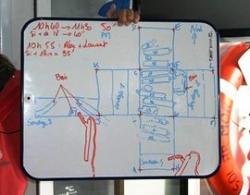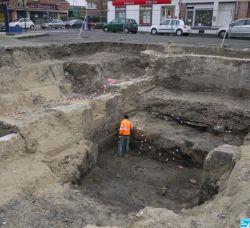29 - 30 OCTOBRE
INDI-UNI : ANTHROPOLOGIE - ARCHEOLOGIE
INSCRIPTION 2011 – 2012 COURS A DISTANCE
REGISTRATION 2011 – 2012 ONLINE COURSES
FRANCE –  Saint Malo - Les eaux malouines, riches en histoire, vont peut-être livrer une nouvelle épave corsaire (après celles de La Natière) à quelques encablures à l’intérieur du barrage de la Rance. L’Association pour le Développement de la Recherche en Archéologie Maritime y expertise actuellement un site où reposent une dizaine de canons qui pourraient appartenir au César, coulé en 1692. Ces travaux s’inscrivent dans une coopération européenne en vue d’éditer un atlas international, avec le concours des Belges et des Anglais.
Saint Malo - Les eaux malouines, riches en histoire, vont peut-être livrer une nouvelle épave corsaire (après celles de La Natière) à quelques encablures à l’intérieur du barrage de la Rance. L’Association pour le Développement de la Recherche en Archéologie Maritime y expertise actuellement un site où reposent une dizaine de canons qui pourraient appartenir au César, coulé en 1692. Ces travaux s’inscrivent dans une coopération européenne en vue d’éditer un atlas international, avec le concours des Belges et des Anglais.
http://www.ouest-france.fr/ofdernmin_-Des-archeologues-explorent-une-epave-pres-du-barrage-de-la-Rance_40771-2005356-pere-bre--61001-abd_filDMA.Htm
FRANCE –  Dunkerque - L'équipe de l'INRAP a mené ses recherches à deux endroits de la place Salengro, jusqu'à sept mètres de profondeur : le long de la rue Ronarc'h et du côté de la placette à l'arrière du beffroi. Dans le sous-sol de cette dernière zone, les archéologues ont mis au jour des vestiges datant du bas Moyen-Âge, dont « les premiers niveaux du marché au poisson et quelques fosses médiévales », détaille David Labarre. Sur cette zone, la présence du marché au poisson a protégé les strates plus anciennes. Le long de la rue Ronarc'h, en revanche, les niveaux souterrains les plus anciens ont été détruits par les constructions du XIXe siècle, dont les traces sont elles bien visibles : « Nous avons trouvé essentiellement des caves du XIXe siècle très bien conservées », note David Labarre. À cette époque, les habitations ont été élevées à la place de l'ancien canal comblé au XVIIIe, indique l'archéologue. Un ancien canal dont l'INRAP a retrouvé les traces des berges, d'abord bordées de pieux en bois puis maçonnées avec un mur d'un mètre de large. Aujourd'hui, au plus profond de ce que les archéologues ont sondé, on voit d'ailleurs l'eau remonter.
Dunkerque - L'équipe de l'INRAP a mené ses recherches à deux endroits de la place Salengro, jusqu'à sept mètres de profondeur : le long de la rue Ronarc'h et du côté de la placette à l'arrière du beffroi. Dans le sous-sol de cette dernière zone, les archéologues ont mis au jour des vestiges datant du bas Moyen-Âge, dont « les premiers niveaux du marché au poisson et quelques fosses médiévales », détaille David Labarre. Sur cette zone, la présence du marché au poisson a protégé les strates plus anciennes. Le long de la rue Ronarc'h, en revanche, les niveaux souterrains les plus anciens ont été détruits par les constructions du XIXe siècle, dont les traces sont elles bien visibles : « Nous avons trouvé essentiellement des caves du XIXe siècle très bien conservées », note David Labarre. À cette époque, les habitations ont été élevées à la place de l'ancien canal comblé au XVIIIe, indique l'archéologue. Un ancien canal dont l'INRAP a retrouvé les traces des berges, d'abord bordées de pieux en bois puis maçonnées avec un mur d'un mètre de large. Aujourd'hui, au plus profond de ce que les archéologues ont sondé, on voit d'ailleurs l'eau remonter.
http://www.lavoixdunord.fr/Locales/Dunkerque/actualite/Secteur_Dunkerque/2011/10/29/article_place-salengro-les-archeologues-en-ont-f.shtml
JAMAIQUE – Bluefields - Crafting an alternative model of resort development, the citizens of Bluefields, Westmoreland, are opening up their Taino artefacts to the world. Their latest project comes four years after a Taino site and an early colonial-era blacksmith's shop were found in the area. The site was discovered in 2007 when bulldozers disturbed it during a housing development. The Tainos are Jamaica's first inhabitants, dating back to 1200 AD; however, the archaeologist points out that very few Jamaicans claim their heritage, even though their impact on the country was enormous remnants of structures. An archaeologist dream, the find came from a midden (garbage dump). It includes broken pieces of pottery vessel, griddles where the Tainos would make their cassava cakes, stone and shell tools, adornments mostly made from shells, and most importantly, remains of their diet."Animal bones, marine resources, essentially the remains of their dinners, are some of the things we have found," said Savery, adding that they are digging through Taino garbage; hoping to find remnants of structures and their living spaces. Come January 2012, an excavation team from a number of universities in the United States will meet up with local experts to delve into the historical gold mine that the citizens are sitting on.
http://jamaica-gleaner.com/gleaner/20111030/lead/lead4.html
USA - Cedar Swamp - For several months last fall, Leveillee, accompanied by a survey team, conducted a dig in Cedar Swamp at the proposed site of the future CSX TRANSFLO station. The purpose of the dig was to locate, analyze and remove for preservation any historical artifacts that might be hidden beneath the soil before construction began. Along with presenting his findings at the event, Leveillee provided for Westborough residents a glimpse into New England life thousands of years ago. "I'm a time traveler and a garbage man at the same time. I excavate bits and pieces from the past that provide insight of what cultures were like long ago. But those bits and pieces are just small samples of a larger culture," said Leveillee. He went on to explain how 13,000 to 12,000 years ago people and mammals migrated from what is now called Russia across a land mass that was once connected to today's Alaska. By following the animals (i.e. food source), the humans moved rapidly across North America and down into South America. During this time period, the first humans arrived in New England. During the survey of Cedar Swamp, Leveillee unearthed Native American artifacts dating back 6,000 years ago. The survey team found fragments of pottery and animal bones, along with stone woodwork tools that almost certainly were used for making the canoes that once glided over Cedar Swamp. How Cedar Swamp appears today is very different from the lake dotted with small islands that once occupied the area thousands of years ago, Leveillee explained. He spoke of how the lake's water and its available resources repeatedly attracted the Native Americans to the area. The varying projectile points for hunting discovered at the site illustrated how people populated the area over a span of time, and the discovered pottery remains signify that people visiting the area transitioned from hunters and gatherers to families occupying the area most likely year round, Leveillee noted.
http://westborough.patch.com/articles/westborough-inhabitants-lived-6-000-years-ago
ITALIE – Pompei - Italian archaeologists were assessing the damage at Pompeii after a new collapse was reported at the popular historic site. Officials from the Uil labour union reported the collapse in the Domus of Diomede on Via Consolare, where two modern walls crumbled in the past few days after heavy storms. There was an outcry last Friday when an eight-square metre section of a wall fell near the Nola Gate.
http://www.ansa.it/web/notizie/rubriche/english/2011/10/27/visualizza_new.html_666882512.html
INDE – Kalugutla - The city police on Wednesday recovered as many as 115 gold coins from the villagers of Kalugutla in Andhra Pradesh's Mahbubnagar district that were found in a farm land. Some workers and villagers stumbled upon the gold coins that were kept in small pots while they were removing weeds from an agricultural land at Kalugutla village at Manapadu mandal on Tuesday and distributed some coins amongst themselves. However, some villagers informed the matter to the police. So far, 115 gold coins have been recovered, a police officer said. "After the information, we recovered 115 gold coins weighing between 1-3 grams each from the villagers. The coins appear very old. Searches are on to locate if there are some more gold coins. The Manapadu Tahasildar and Archaeological department officials are also enquiring from the villagers about the gold coins and verifying as to which era the coins date back to," he said.
http://www.ndtv.com/article/cities/115-gold-coins-found-in-farmland-in-andhra-pradesh-village-144404